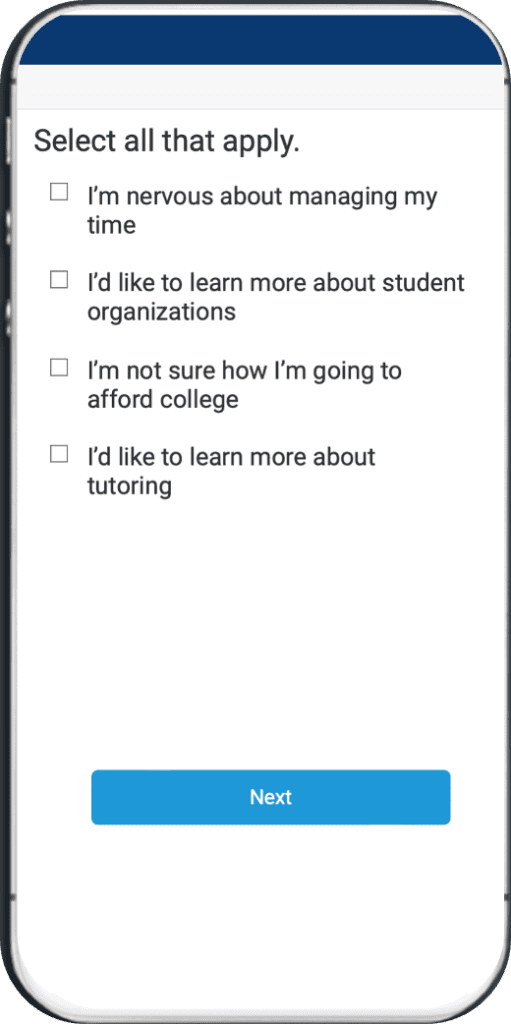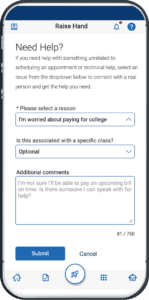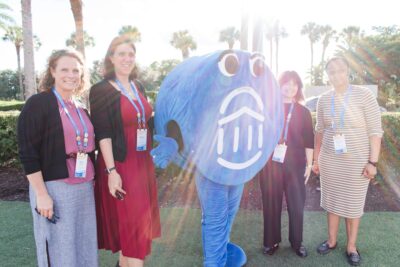3 ways to combat the student loneliness epidemic on your community college campus
The biggest challenge some students will face this fall isn’t academic—it’s finding a friend. Gen Z is entering college more isolated, anxious, and unsure of their place than any generation before them.
Building friendships, connecting with faculty, and stepping outside your comfort zone have always been important parts of the college experience. In the past, students actively sought out these moments. But today, many educators say Gen Z students are more withdrawn, less engaged, and hesitant to form new relationships.
Simply put, they are lonely. Many lack close friendships and real-life social support. Some will start the semester already feeling disconnected, and arriving on a new campus surrounded by strangers can make that feeling even more intense. In this blog post, I’ll explore the pervasiveness of the loneliness crisis, its impact, and what your community college can do today to combat it.
Understanding the loneliness crisis
The severity of the loneliness crisis is emphasized by the U.S. Surgeon General, Dr. Vivek Murthy, who has declared loneliness a “public health epidemic,” warning that the emotional pain of isolation carries serious health risks—including elevated chances of heart disease, stroke, dementia, depression, anxiety, premature death, substance misuse, and even violence. He highlights that young adults are among the most affected: approximately 73% of individuals aged 16–24 report struggling with loneliness, underscoring the urgent need to prioritize social connection, meaningful relationships, and community support for Gen Z.
Among young men, the loneliness crisis is even more pronounced. A recent Gallup poll found that 1 in 4 American men ages 15 to 34 reported feeling lonely “a lot”—significantly higher than the national average of 18% and notably above the rate for young women, which is also 18%. These young men are also reporting high levels of daily stress and worry, creating threats to their ability to finish college, start a career, and thrive in their communities.
Lastly, specifically on college campuses, stress and loneliness are prevalent. In spring 2023, Gallup found that while 76% of students said they enjoyed their day, 66% also reported feeling stressed, 51% felt worried, and 39% felt lonely for much of it. These findings highlight a clear gap between how students appear on the surface and the emotional challenges they may be facing privately.
Why does this matter for our work in higher education? First and most importantly, we care about students as whole people. But it also matters because students who feel like they belong are more likely to stay enrolled, engage in their classes, and ultimately graduate. Research also shows that a strong sense of belonging is especially important for students from historically marginalized backgrounds, who often face more barriers to connection and community on campus. When students feel supported and included, their confidence and motivation grows—and so does their ability to thrive academically.
And, if you’re with your people, and you won’t have to do it alone. Because life is not a solo act. No, it’s not. It’s a big, messy, delightful ensemble piece, especially when you’re with your people.
Kermit the Frog
University of Maryland commencement address, May 22, 2025
Here are three ways that your college can build belongingness and combat loneliness going into the new academic year.
1. Build Early Connections Through Welcome Surveys
No one likes getting invited to events that don’t match their interests—think of an engineering student getting constant emails about business club meetings. Instead, colleges can use welcome surveys to ask students directly about what sparks their interest, what kinds of activities they’d show up for, and how connected they’re feeling to the campus community. (Some colleges may call these intake surveys- we like “welcome” or “onboarding” because of the risk of intake sounding clinical).
Welcome surveys give us valuable insight that helps colleges send more targeted invitations to clubs, sports teams, volunteer opportunities, and organizations that match student interests. They also make it easier to personalize broader campus events. Inviting students to an activities fair is a good start, but saying something like, “We saw you’re interested in leadership. Visit the Student Government Association at table 10,” makes the experience feel more personal. These small touches help students feel seen and increase their sense of belonging on campus.

Welcome surveys can do more than collect information. They can also help connect students to the right support. Based on a student’s answers, the survey might ask follow-up questions like “Would you like us to connect you with one of these organizations?” or “Would you like to talk to someone about how you’re feeling about college?” This makes it easier for student success teams to follow up quickly and offer help when it’s needed most.
At Northeast Wisconsin Technical College, for example, their intake survey refers students to well-being resources, personal counseling, and campus activities. Students at NWTC who receive a referral and follow up with an advisor are 19% more likely to stay enrolled from fall to spring compared to those who do not.
Through Navigate360, community colleges can launch surveys, polls, and messaging campaigns that can help students feel more connected and make friends.
Technology’s Role in Belonging: Tips to Understand and Empower Student Inclusion on Campus
2. Create Friendship and Connection Initiatives
Many student success efforts, especially ones at the start of the semester, are focused on the mechanics of being a new student. Do you have your student ID? Can you log in to your email? These are important, but they can quickly overwhelm students and leave them feeling anxious at the start of the semester.
Building connections should be treated as just as important as getting a parking pass or buying books. Colleges can help by creating initiatives that normalize the desire to make new friends and acknowledge that feeling lonely is a common part of the college experience. When institutions name these emotions and show that social connection is a priority, even shy or hesitant students may feel more comfortable reaching out. Making it easy—and completely okay—to say, “I want to meet people” helps students take that first step toward building meaningful relationships.
Here are ways institutions across the country are helping students create relationships with their peers:
- Arizona State University’s All Ears Friendship Bench: ASU’s Friendship Bench program pairs student volunteers with retired residents from the community, encouraging them to sit, chat, and connect. The program helps ease student loneliness while also fostering meaningful intergenerational relationships.
- Harper Community College’s Buddy System: HCC’s Buddy System pairs students to help them make friends and build connections, whether they are taking classes in person or online. Participants receive weekly conversation prompts, invitations to special events, and small giveaways to support relationship-building throughout the semester.
- Elgin Community College’s “You’ll Fit Right In” campaign: This campaign reinforces their commitment to equity, diversity, and inclusion by spotlighting real student voices and stories. Featuring a multimedia mix of commercials, billboards, and mailers, the campaign aims to let every prospective and returning student know that ECC is a welcoming, supportive place where they belong and can succeed.
A tech-enabled approach can also give students an easy way to ask for help when something doesn’t feel right whether they’re feeling lonely, anxious, or just unsure. Navigate360’s hand raise feature lets students request support anytime, from anywhere, from the privacy of their phone. Colleges can then follow up with resources that match the student’s needs, such as peer mentorship, student groups, faculty connections, or mental health support.
3. Host Small, Low-Stakes, Fun Events
I worked in community college student life for years. My very first campus job was as an activities coordinator, and to be honest, some of my colleagues saw our work as just “fluff.” To them, we were just the team handing out free t-shirts, serving pizza, and hosting board game nights.
The truth is, we were doing those things—and so much more. What people didn’t always see was the way a student’s face lit up when they finally worked up the courage to come to a movie night. Or how a quiet student could sign up to pack boxes for a food drive and end up making a new friend. I’d see those free t-shirts worn proudly around town, a small but powerful sign of belonging. Over time, it became clear that even the simplest moments could help students feel seen, heard, and part of something bigger.

At the start of the semester, many students feel unsure about how to jump into campus life, especially if they don’t know anyone yet. Hosting low-pressure, interest-based events gives students a comfortable way to meet others without the intimidation of large, formal gatherings. EAB’s research shows that students prefer smaller events where they can get to know a few people, versus being mixed in with hundreds of their peers.
Think casual game nights, coffee and conversation hours, outdoor picnics, crafting meetups, or themed lunches centered around shared interests like movies, music, or cultural heritage. These events should be designed with solo attendees in mind, offering built-in conversation starters or guided activities to help spark interaction. By creating a relaxed, welcoming atmosphere, colleges make it easier for students to take that first social step and begin building their campus community.
Keeping track of who attends campus events can help your college stay connected with students and keep them engaged throughout the semester. With Navigate360, institutions can easily monitor event participation and follow up with personalized outreach. Navigate360 also includes an AI-powered content creation tool that quickly helps staff craft targeted invitations and messages to encourage students to join future activities.

How can I learn more?
Students come to campus in search of a degree, but they are also looking for meaningful connections. Navigate360 supports college teams in addressing student loneliness and building a stronger sense of belonging by offering tools to launch intake surveys, send targeted messages, promote campus events, and give students a simple way to raise their hand for help when they need it. To learn more about how you can help increase student belongingness this fall, contact us here.

More Blogs

Four signs it’s time to break up with your student CRM

Three lessons from 1,200 student success leaders on higher ed’s future
